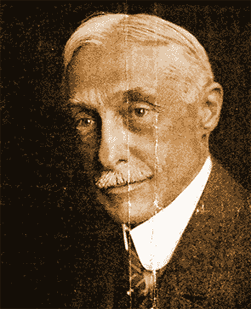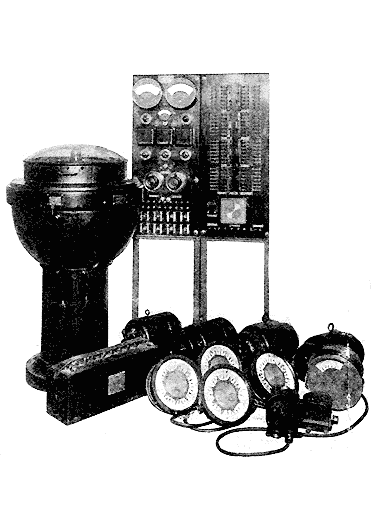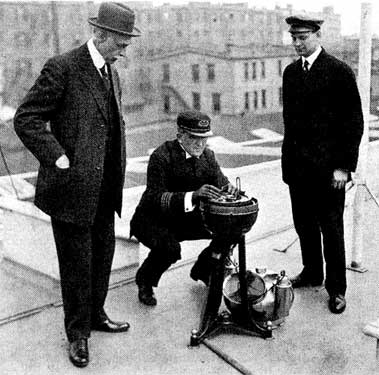Elmar A. Sperry und die Sperry Gyroscope Company

The Sperry Gyroscope Company was named after its founder, Elmer A. Sperry, and established on April 19, 1910, with no outside financing, no products, no employees, but with an "unquenchable enthusiasm". Sperry Gyroscope grew to be a multinational technological powerhouse known the world over. Through over 80 years of maritime and naval history, Sperry Marine tracks its lineage back to Dr. Sperry's famous company. This is an abbreviated history of the Sperry Marine Company and its evolution from those early beginnings to the company that today is recognized as one of the preeminent marine technology and manufacturing companies in the world.
Born in 1860 in Cortland, New York, Elmer Sperry became a noted engineer and inventor, respected the world over for his engineering talent and dogged enthusiasm for all things mechanical. Like a similar inventor of his time, Thomas A. Edison, Elmer Sperry's interests ranged far and wide. As Preston Bassett, President of Sperry Gyroscope in 1950 said on the occasion of the company's 40th anniversary, "Mr. Sperry was primarily an inventive, mechanically minded Yankee" who possessed a "restlessness which motivated all the rest of his life". Sperry would eventually become involved in the technologies and development of dynamos, mining equipment, trolleys, electric cars, batteries, the new field of aviation, and many, many others. His interests, like those of Edison, were many and varied and led from one challenge to the next. Elmer Sperry, at the time of his death in 1930, had authored and was granted over 360 patents.
 C.A. Bohnenberger is generally credited with the first recorded construction of a gyroscope in 1810. L. Foucault (of Pendulum fame) first conceived of the gyro as an inertial reference in 1851. In 1890, one other event was to set the stage for the practical application of the gyrocompass; the development of the first electrically driven gyroscope by G.M. Hopkins. Thus it was that in the last decade of the 19th century, the stage was set for the application of the gyroscope to real world problems. These were quick in coming; three things drove the transformation of the gyroscope from a child's toy, or inventor's curiosa to that of a usable technology. These were the increasing use of steel in ships which then brought about the second need; to overcome the unreliability of the magnetic compass within a steel ship, and finally, the great powers were preparing to conduct underwater warfare - in steel hull ships. In this age of the Edison's, Bell's and Wright brothers, two further inventors, one on either side of the Atlantic, sought solutions to these problems.
Dr. H. Anschutz of Germany and Elmer Sperry both built on the properties of the gyroscope; stability and precession. A gyroscope will always point to a fixed point in space if left undisturbed. If force is exerted upon it, it will react at right angles to the force applied. This characteristic of a gyro combined with other elements of precession, pendulocity and damping will allow the gyro to settle toward true north. In 1908 Dr. Anschutz patented the first north seeking gyrocompass with the United Kingdom's Patent Office (Patent Number 10382/08). That same year, Elmer Sperry invented and introduced the first ballistic gyrocompass, which included vertical damping (his device was subsequently patented with the British in 1911 - Patent Number 15669/11). Both of these first devices were of the single pendulum type.
C.A. Bohnenberger is generally credited with the first recorded construction of a gyroscope in 1810. L. Foucault (of Pendulum fame) first conceived of the gyro as an inertial reference in 1851. In 1890, one other event was to set the stage for the practical application of the gyrocompass; the development of the first electrically driven gyroscope by G.M. Hopkins. Thus it was that in the last decade of the 19th century, the stage was set for the application of the gyroscope to real world problems. These were quick in coming; three things drove the transformation of the gyroscope from a child's toy, or inventor's curiosa to that of a usable technology. These were the increasing use of steel in ships which then brought about the second need; to overcome the unreliability of the magnetic compass within a steel ship, and finally, the great powers were preparing to conduct underwater warfare - in steel hull ships. In this age of the Edison's, Bell's and Wright brothers, two further inventors, one on either side of the Atlantic, sought solutions to these problems.
Dr. H. Anschutz of Germany and Elmer Sperry both built on the properties of the gyroscope; stability and precession. A gyroscope will always point to a fixed point in space if left undisturbed. If force is exerted upon it, it will react at right angles to the force applied. This characteristic of a gyro combined with other elements of precession, pendulocity and damping will allow the gyro to settle toward true north. In 1908 Dr. Anschutz patented the first north seeking gyrocompass with the United Kingdom's Patent Office (Patent Number 10382/08). That same year, Elmer Sperry invented and introduced the first ballistic gyrocompass, which included vertical damping (his device was subsequently patented with the British in 1911 - Patent Number 15669/11). Both of these first devices were of the single pendulum type.
